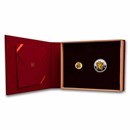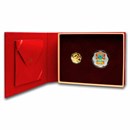Chinese Mint Gold All Other
All Other Gold from the Chinese Mint
The Chinese Mint, also known as the China Gold Coin Incorporation (CGCI), is one of the largest mints in the world, and it produces a wide range of gold products. Here are some key things to know about gold from the Chinese Mint:
- Gold Panda Coins: The Chinese Mint is perhaps best known for its Panda Gold Coins. These coins have been produced since 1982 and feature an image of a panda on the front. The design of the panda changes each year, making these coins popular among collectors.
- Other Gold Coins: In addition to the Panda Gold Coins, the Chinese Mint produces several other gold coins, including Lunar Gold Coins and Historical Figures Gold Coins. These coins are also popular among collectors.
- Gold Bars: The Chinese Mint also produces gold bars in a variety of sizes, ranging from 5 grams to 1 kilogram. These bars are popular among investors who want to buy gold bullion.
- Quality: The Chinese Mint is known for producing high-quality gold products. The gold used in these products is 99.9% pure and meets international standards.
- Legal Tender: The Panda Gold Coins and other gold coins produced by the Chinese Mint are legal tender in China. This means that they can be used as currency, although their value as collectibles is typically much higher than their face value.
Overall, gold from the Chinese Mint is highly regarded for its quality and collectibility. Whether you are an investor or a collector, there are a wide range of gold products to choose from.
History of the Chinese Mint
The history of the Chinese Mint dates to the late 19th century when China began modernizing its currency system. In 1889, the Qing Dynasty government established the Central Mint in Tientsin (now Tianjin) to produce coins for circulation throughout the country. The mint was later moved to Nanjing in 1920.
After the establishment of the People's Republic of China in 1949, the Central Mint was reorganized as the People's Bank of China and tasked with producing banknotes. A new mint, the Shanghai Mint, was established in 1949 to produce coins.
In 1982, the China Gold Coin Incorporation (CGCI) was established as a subsidiary of the People's Bank of China to produce gold and silver coins. The CGCI is responsible for producing the popular Panda Gold Coins, which are highly regarded by collectors around the world.
Today, the Chinese Mint operates several facilities across China, including the Shenyang Mint, the Shanghai Mint, and the Nanjing Mint. These facilities produce a wide range of coins and medals, as well as gold and silver bullion products.
With a long history, the Chinese Mint has many interesting facts it has accumulated over the years – here are some of the most fascinating:
- Early Chinese coins: China has a long history of producing coins, with the earliest coins dating back to the 7th century BCE. These early coins were made of bronze and had a square hole in the center.
- Chinese monetary system: The Chinese monetary system was based on the use of coins for many centuries, with paper money only becoming widespread during the Ming Dynasty (1368-1644).
- The first Chinese paper money: The first paper money in China was introduced during the Tang Dynasty (618-907), but it was not widely used until the Song Dynasty (960-1279).
- The role of foreign mints: Prior to the establishment of the Central Mint in 1889, many Chinese coins were produced by foreign mints, including mints in Japan and Great Britain.
- Coins as art: Chinese coins have long been appreciated as works of art, with many coins featuring intricate designs and calligraphy. Some of the most famous Chinese coins include the "Flying Dragon" coin from the Ming Dynasty and the "Three-legged Buddha" coin from the Qing Dynasty.
- Modernization efforts: In addition to the establishment of the Central Mint in 1889, China also modernized its currency system in the 1930s, introducing a decimal system and new banknotes. The current renminbi currency system was introduced in 1948.
The Chinese Mint is known for its high-quality products and innovative designs, and it has played an important role in China's monetary history.













